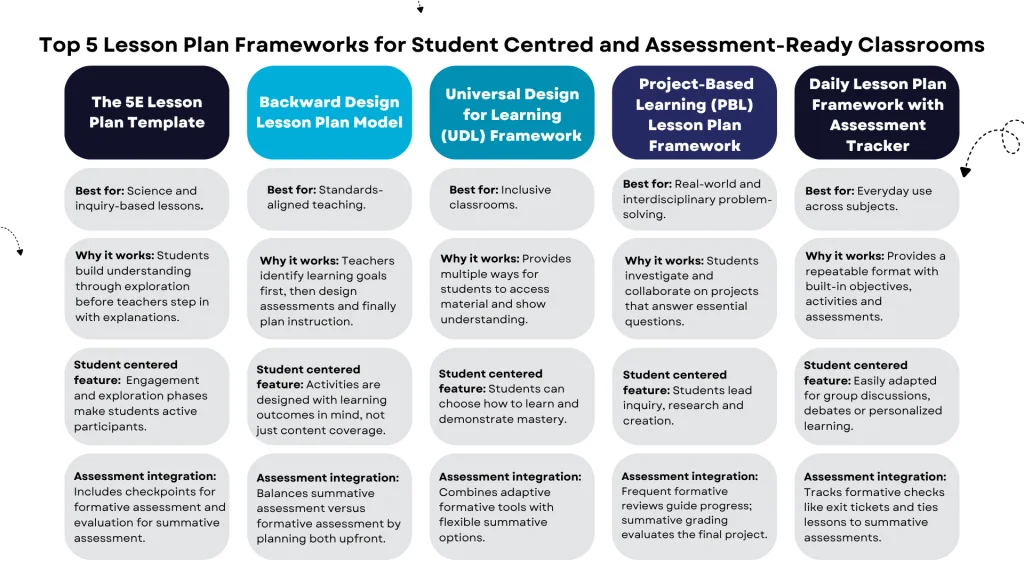Schedule a free demo to learn more
Top 5 Lesson Plan Frameworks for Teachers: Designed for Student Centred and Assessment-Ready Classrooms
3rd Oct 2025

Today’s teachers are expected not only to deliver lessons but to design experiences that are student centred, measurable and assessment-ready. With AI-powered tools and digital teaching aids on the rise, the demand for adaptable, structured lesson plan templates is higher than ever.
This blog explores the top 5 lesson plan frameworks for teachers, with a focus on student centred strategies and embedding summative assessment versus formative assessment into daily practice.
Why Lesson Plan Templates are Essential for Teachers
A lesson plan template provides structure and clarity. Instead of starting from scratch every day, teachers can use lesson plan templates that:
- Save preparation time.
- Keep lessons aligned with curriculum goals.
- Integrate summative assessment versus formative assessment naturally.
- Create opportunities for differentiated instruction.
Well-designed lesson plan templates are not just about what to teach. Instead, they focus on how to teach in a student centred way that drives real learning outcomes.
What does Student Centered Lesson Planning mean?
A student centred classroom shifts focus from teacher-led delivery to student-led discovery. This means:
- Encouraging active participation and collaboration.
- Building critical thinking and problem-solving into every lesson.
- Allowing student choice and autonomy.
- Adapting content to diverse learning styles.
When paired with flexible lesson plan templates, student centred planning ensures lessons are meaningful, engaging and impactful.
Summative Assessment Vs. Formative Assessment in Lesson Plans
What is the difference between summative assessment and formative assessment, and how should each fit into lesson plans? Here’s the answer:
Formative Assessment: Conducted during the learning process to check understanding and provide feedback.
Examples: Quick quizzes, exit tickets, class polls, reflective journals.
Summative Assessment: Conducted at the end of a unit or topic to measure mastery.
Examples: final projects, essays, unit exams.
Good lesson plan templates often combine both. Formative tools keep students on track daily, while summative tasks validate long-term learning.
Top 5 Lesson Plan Frameworks for student centred and Assessment-ready classrooms

The 5E Lesson Plan Template (Engage, Explore, Explain, Elaborate, Evaluate)
Best for: Science and inquiry-based lessons.
Why it works: Students build understanding through exploration before teachers step in with explanations.
Student centred feature: Engagement and exploration phases make students active participants.
Assessment integration: Includes checkpoints for formative assessment and evaluation for summative assessment.
2. Backward Design Lesson Plan Model
Best for: Standards-aligned teaching.
Why it works: Teachers identify learning goals first, then design assessments and finally plan instruction.
Student centred feature: Activities are designed with learning outcomes in mind, not just content coverage.
Assessment integration: Balances summative assessment versus formative assessment by planning both upfront.
3. Universal Design for Learning (UDL) Framework
Best for: Inclusive classrooms.
Why it works: Provides multiple ways for students to access material and show understanding.
Student centred feature: Students can choose how to learn and demonstrate mastery.
Assessment integration: Combines adaptive formative tools with flexible summative options.
4. Project-Based Learning (PBL) Lesson Plan Framework
Best for: Real-world and interdisciplinary problem-solving.
Why it works: Students investigate and collaborate on projects that answer essential questions.
Student centred feature: Students lead inquiry, research and creation.
Assessment integration: Frequent formative reviews guide progress; summative grading evaluates the final project.
5. Daily Lesson Plan Framework with Assessment Tracker
Best for: Everyday use across subjects.
Why it works: Provides a repeatable format with built-in objectives, activities and assessments.
Student centred feature: Easily adapted for group discussions, debates or personalized learning.
Assessment integration: Tracks formative checks like exit tickets and ties lessons to summative assessments.
How to choose the right Lesson Plan Framework
When selecting lesson plan templates, consider:
- Subject area: Science fits 5E; interdisciplinary lessons benefit from PBL.
- Student needs: UDL works best for inclusion.
- Assessment type: Backward design ensures balance between summative assessment versus formative assessment.
- Frequency: Daily templates simplify regular planning.
FAQs Teachers Ask About Lesson Plan Templates
1. What are examples of lesson plan frameworks?
Examples include the 5E model, Backward Design, UDL templates, Project-Based Learning formats and daily trackers with assessment sections.
2. Which is better, summative assessment or formative assessment?
Neither is ‘better’. They serve different purposes. Formative assessments guide instruction, while summative assessments confirm learning. The best lesson plan templates include both.
3. How do I make lesson plans more student centred?
Add choice (topics or project formats), use collaboration and include reflection opportunities. TmLesson plan frameworks like PBL and UDL make this easier.
4. Can AI help create lesson plan templates?
Yes. AI-powered platforms can generate customized templates, suggest assessments and adapt lessons to student needs.
5. Do I need different lesson plan templates for different grades?
Not necessarily. Templates like Backward Design or Daily Trackers are flexible across grade levels. Subject-heavy classes may benefit from specialized templates like 5E for science.
6. How do lesson plan templates help with student centred teaching?
They give structure while allowing flexibility. Teachers can integrate group work, projects, and choice-based activities without losing sight of objectives.
7. Why include both Summative Assessment versus Formative Assessment in lesson plans?
Because formative assessments guide learning in real time, while summative assessments measure mastery. A combination ensures teaching is responsive and outcome-driven.
Final Thoughts: Why Lesson Plan Templates Matter
The right lesson plan template is more than a worksheet. It’s a roadmap for student centred teaching. By embedding summative assessment versus formative assessment into lessons, teachers ensure their classrooms are structured, engaging and effective.
Whether you use Backward Design, PBL, UDL or a simple daily template, these tools empower teachers to deliver learning that lasts.
At Edusfere, we believe in smarter solutions for modern classrooms. Our customizable lesson plans are built to accommodate all teaching styles and approaches, from student centred learning to PBL, and seamless integration of summative assessment and formative assessment.
Schedule a demo with Edusfere today and discover how our tools can save your time, enhance engagement and help your students thrive.